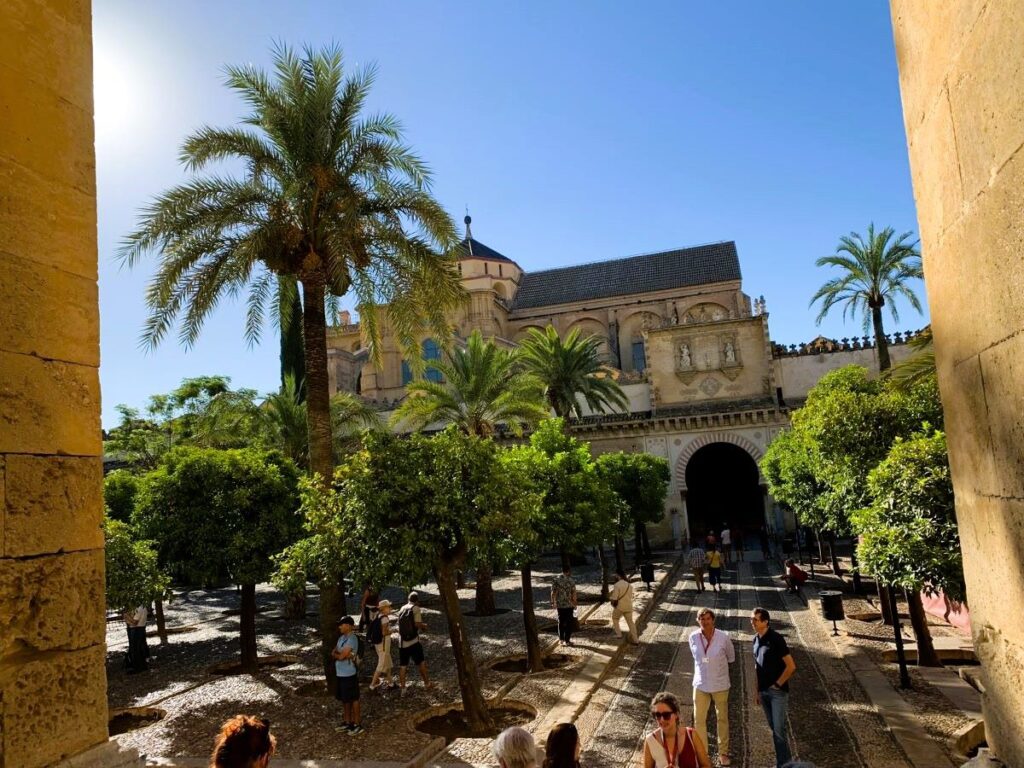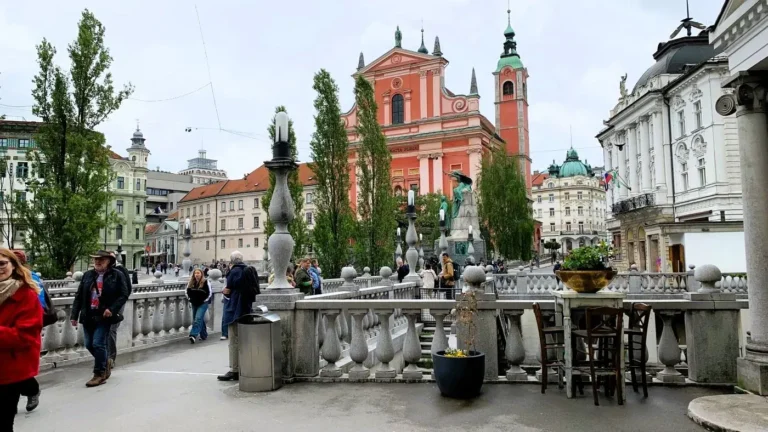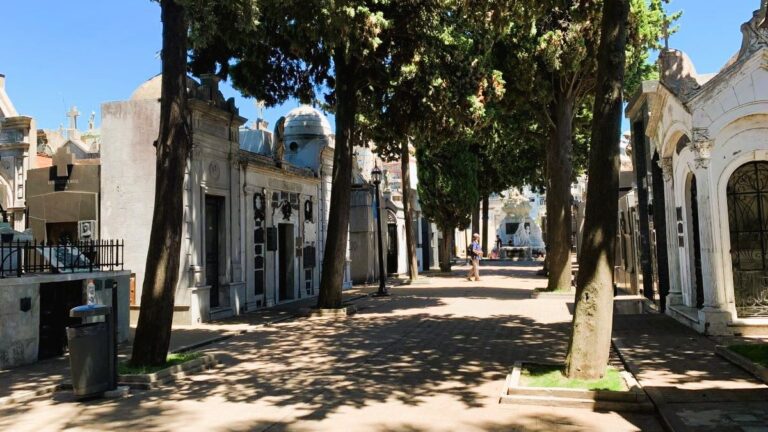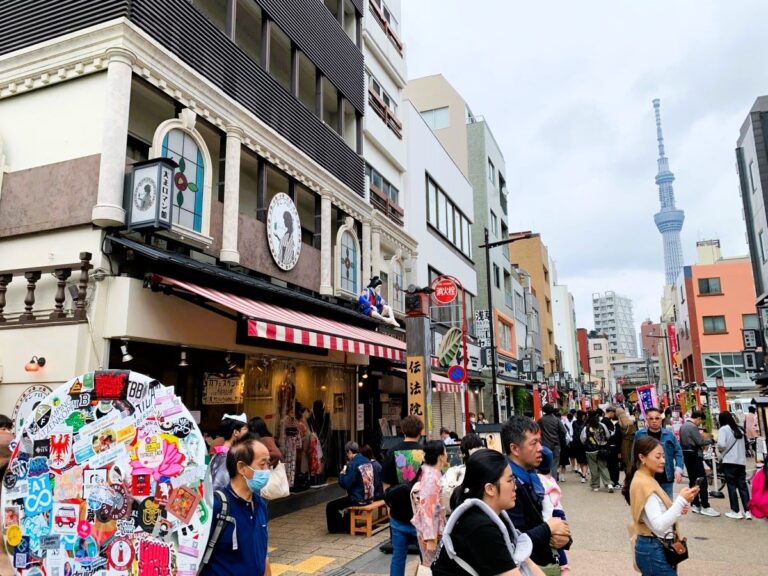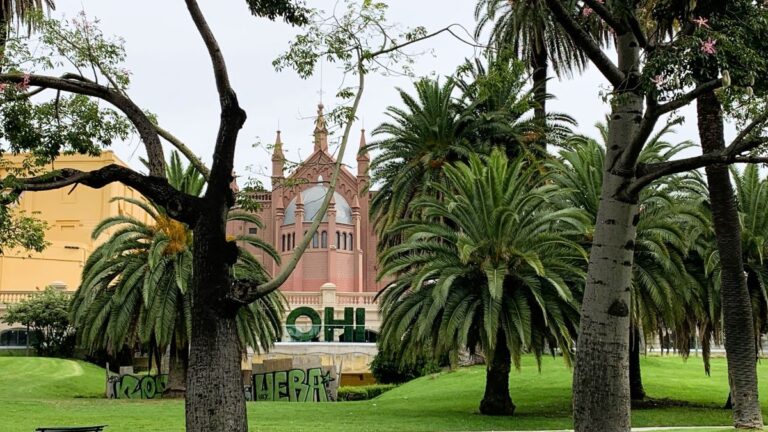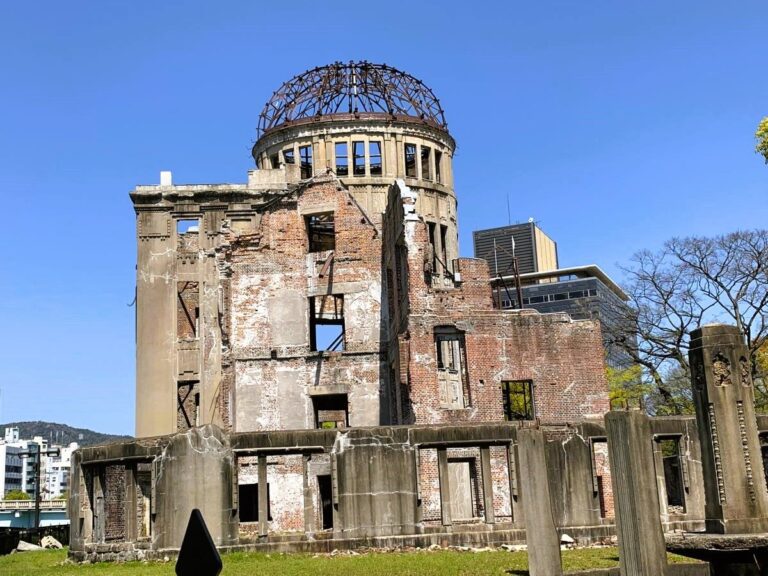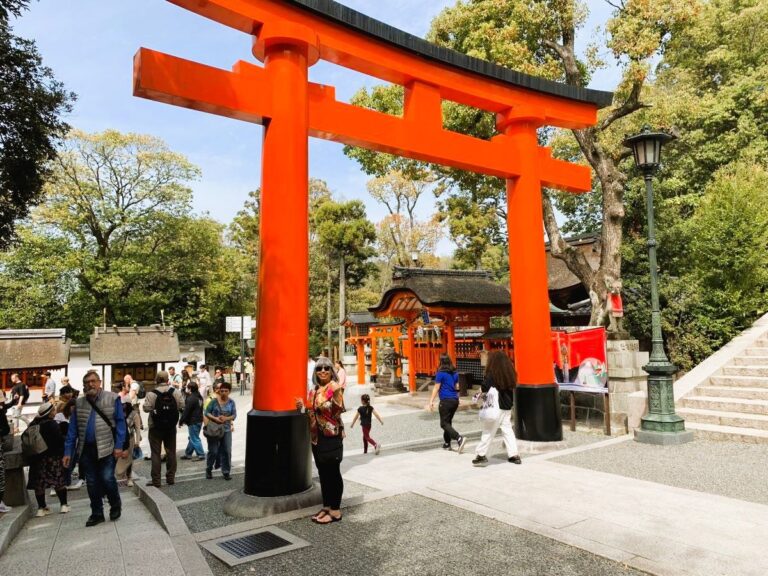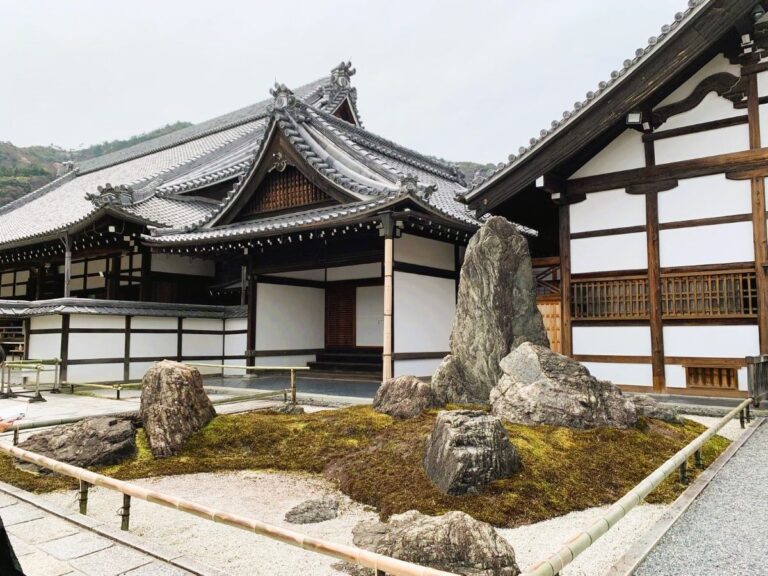Exploring Córdoba’s Jewish Quarter: A Journey Through La Judería
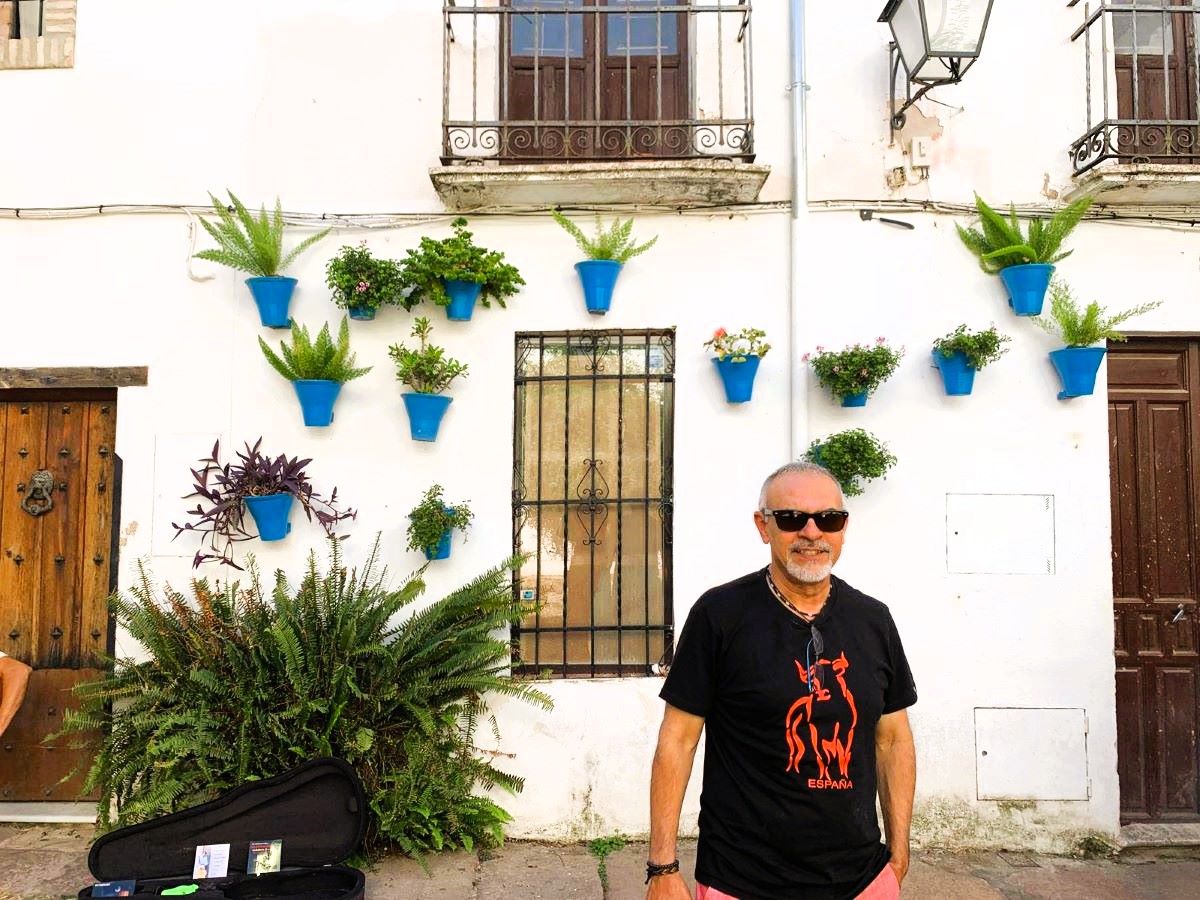
A First-Timer’s Guide to Cordoba Jewish Quarter
Tucked inside the heart of Córdoba, Spain, the Jewish Quarter (La Judería) is one of the city’s most charming and historic areas.
Here you’ll find narrow cobblestone streets, whitewashed walls, and centuries-old traditions.
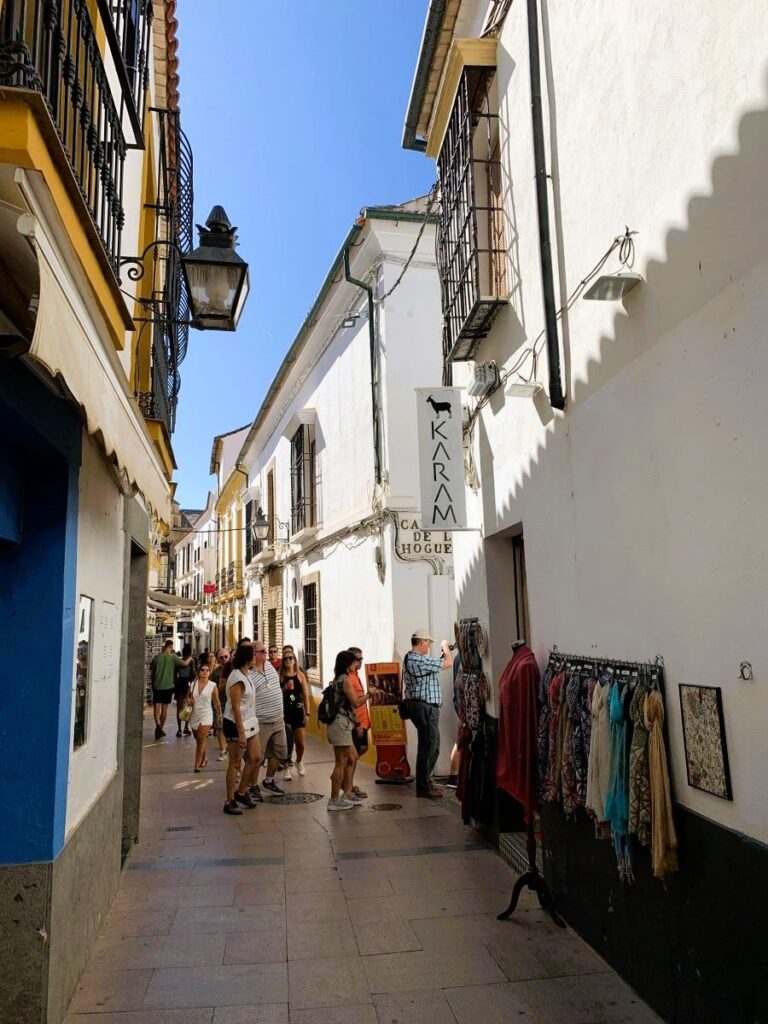
I would also recommend that you stay in this area as most of the attractions are here. Plus, there’s great shopping, excellent restaurants, and amazing tapas bars, all within walking distance.
We had a wonderful stay at Las Casas de la Judería de Córdoba – a really nice hotel. Do check it out.
- For a broader look at what makes this city unforgettable, visit: Is Córdoba Spain Worth Visiting?
- To learn about the Mosque-Cathedral of Cordoba, visit: Exploring the Stunning córdoba Mosque: History, Architecture, and Legacy
Here’s your complete guide to exploring the Jewish Quarter in Cordoba, including what to see, where to eat, and how to make the most of your visit.
What Is the Jewish Quarter?
The Jewish Quarter is a small part of Córdoba’s old town where a large Jewish community lived during the Middle Ages.
Long before Spain became a united country, Córdoba was a city full of learning and culture. Christians, Jews, and Muslims once lived here side by side.
Today, you can still walk the same winding streets, visit a rare medieval synagogue, and learn about the lives of famous Jewish thinkers like Maimonides. It’s a peaceful, beautiful area full of flowers, history, and charm.
The History of the Cordoba Jewish Quarter
Few places capture the mosaic of history quite like the Jewish Quarter in Córdoba. Known as La Judería, this area is a powerful reminder of a community that once thrived, contributed, and endured through both golden ages and times of hardship.
Let’s trace the arc of its history.
The Golden Age Under Islamic Rule
During the Islamic era, Córdoba became a dazzling hub of culture and learning, and the Jewish community flourished under this tolerant regime.
The 10th and 11th centuries, often referred to as the “Golden Age,” saw the city transform into one of Europe’s most advanced centers for science, philosophy, and the arts. Jews actively participated in this flourishing intellectual life, contributing significantly to Córdoba’s prestige.
One of the Jewish Quarter’s most admired figures was Maimonides, born here in 1138. A brilliant philosopher, rabbi, and physician, Maimonides left an indelible mark on Jewish thought.

His works, such as The Guide for the Perplexed, continue to influence not only Jewish theology but also Islamic and Christian philosophies.
You’ll find his statue in Tiberíades Square.
Decline and Expulsion
The fortunes of Córdoba’s Jewish community began to shift with the rise of the Catholic monarchs. By the late 15th century, the atmosphere of coexistence had given way to increased persecution.
In 1492, the signing of the Alhambra Decree by Ferdinand and Isabella marked the end of an era. This infamous directive ordered the expulsion of Jews from all territories under Spanish rule, including Córdoba.
Most Jewish families were forced to convert to Christianity or face exile, leaving the once-vibrant La Judería a shadow of its former self.
The ornate Synagogue, built in 1315, is one of the few structures that survived this turbulent period, offering a glimpse into the Jewish Quarter’s past.
For a detailed understanding of the expulsion and its impact, the Córdoba – Jewish Heritage Guide dives deeper into the story.
The history of the Jewish Quarter is woven into Córdoba’s identity. It reflects not only incredible perseverance but also the enduring legacy of a community that shaped the city’s soul.
Exploring the Streets of La Judería
Strolling down the narrow streets of La Judería, Córdoba’s stunning Jewish Quarter, you’ll find it’s full of history, culture, and charm. Its narrow streets, lined with whitewashed walls and vibrant flowers, will remind you of a once-thriving Sephardic community.
The best way to explore the Jewish Quarter is by walking. Cars can’t even drive down many streets—they’re too narrow! Grab a map (or use your phone) and wander.
If you’d like a deeper understanding of the history, consider joining a walking tour with a local guide. These tours usually last about 1.5 to 2 hours and include stories about the area’s past and important landmarks.
Must-Visit Landmarks
In Córdoba’s La Judería, certain spots simply cannot be missed. These landmarks are historical snapshots of a bygone era.
Córdoba Synagogue
Tucked away on a quiet street and dating back to 1315, this synagogue is one of only three still standing from this period in Spain. Its intricate Mudejar-style stucco work, featuring delicate vine and geometric patterns, tells the story of Islamic and Jewish artistic fusion. You’ll marvel at how preserved it is, a testament to its significance.
Casa de Sefarad
This museum offers an intimate glimpse into the Sephardic Jewish legacy. From ancient manuscripts to recreated traditional Sephardic music, each room brings a piece of history to life. This is where you truly connect with the day-to-day lives of those who once called La Judería home.
Statue of Maimonides
Found in Tiberíades Square, this statue honors one of Córdoba’s most notable figures. Maimonides, a philosopher, physician, and theologian born in the 12th century, left an intellectual legacy that transcended religions and borders. Visitors often rub the statue’s foot for good luck—a tradition worth following!
Maimonides, also known as Rabbi Moses ben Maimon or Rambam, was one of the most famous people to come from Córdoba’s Jewish Quarter. He was born in Córdoba in the year 1135 and became one of the greatest Jewish thinkers of all time.
Maimonides was many things: a philosopher, a doctor, and a rabbi. He studied religion, science, and medicine. He was especially known for bringing together Jewish faith and logic. He believed that religion and reason could work together—not against each other.
When he was young, Córdoba was taken over by a group that didn’t allow Jews to practice their religion freely. Because of this, Maimonides and his family had to leave the city. They traveled through Spain and North Africa before finally settling in Egypt. There, Maimonides became the royal doctor to the Sultan and wrote some of his most important books.
One of his most famous works is called “The Guide for the Perplexed.” It helped people understand how to connect their faith with the world around them, especially during confusing or difficult times. He also wrote important texts about Jewish law that are still used today.
Calleja de las Flores (Alley of Flowers): Córdoba’s Most Photographed Street
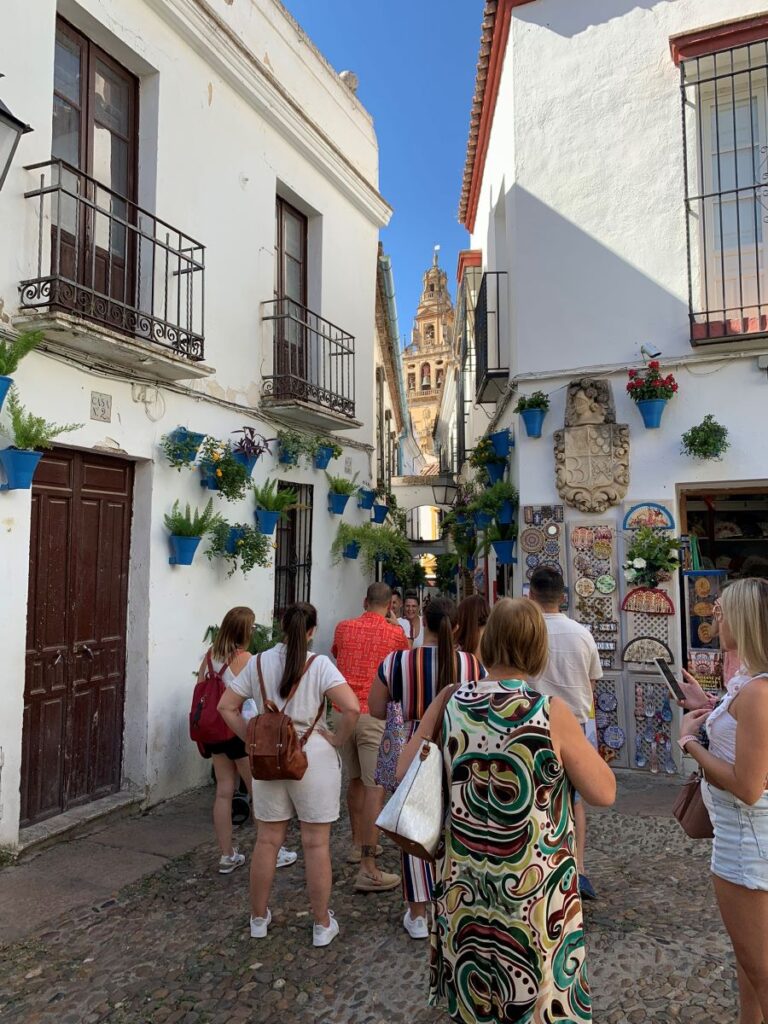
Hidden within the winding streets of Córdoba’s historic Jewish Quarter lies one of the city’s most enchanting treasures — Calleja de las Flores, or the Alley of Flowers. This tiny, picturesque street is famous for its whitewashed walls bursting with colorful flowerpots, and it offers one of the most iconic views in the city: a perfect glimpse of the Mosque-Cathedral’s bell tower framed by blooms and balconies.
Though it’s just a narrow passage, Calleja de las Flores has become a symbol of Córdoba’s charm and beauty, drawing thousands of visitors each year who come for a photo, a stroll, and a moment of quiet wonder.
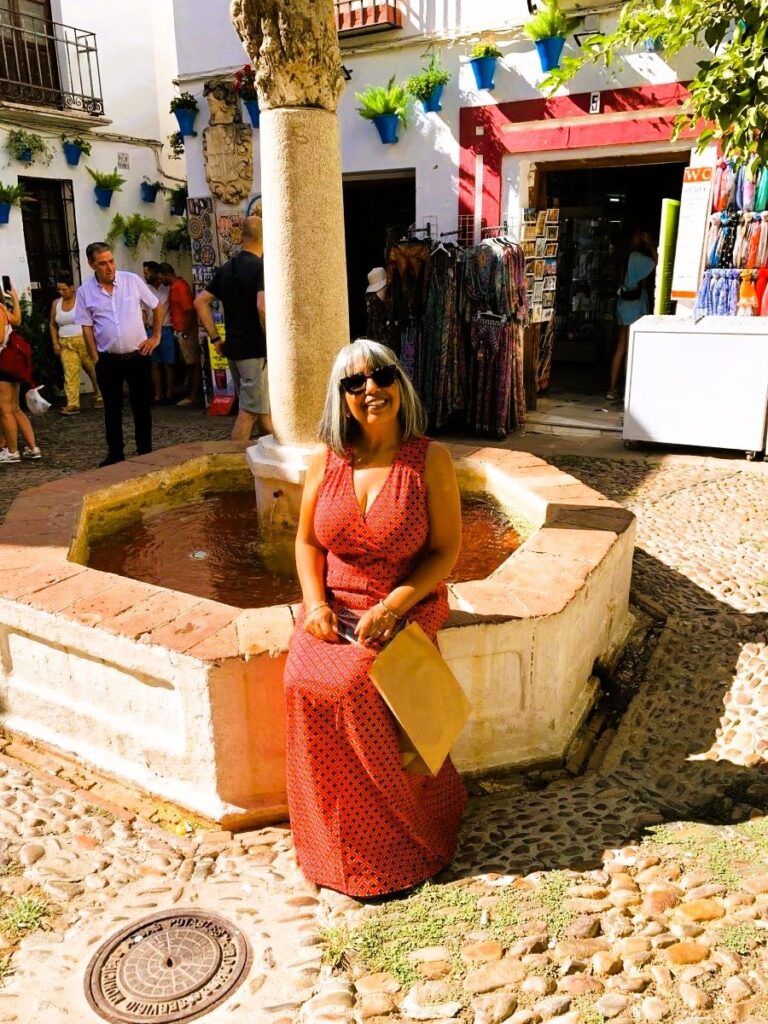

Like much of the Judería (Jewish Quarter), the alley dates back to the medieval period when Córdoba was a cultural crossroads of Muslim, Christian, and Jewish traditions. Over time, the narrow street became a residential area where homes were built tightly together, with shared courtyards and shaded lanes to stay cool in the Andalusian heat.
The tradition of decorating homes with flower-filled patios and balconies grew in Córdoba over the centuries. It reached its full glory in the 20th century, especially during the city’s annual Festival of the Patios. Calleja de las Flores was one of the first streets to become a living example of this colorful tradition.
Córdoba’s Courtyards
Córdoba’s courtyards are small gardens tucked inside homes. Many have been around since Roman times, and they became even more special during the time of the Moors, who brought clever ways to keep homes cool in the hot weather. The patios usually have tiled floors, fountains, and walls covered in flowers like geraniums, jasmine, and bougainvillea. It’s like walking into a secret garden.
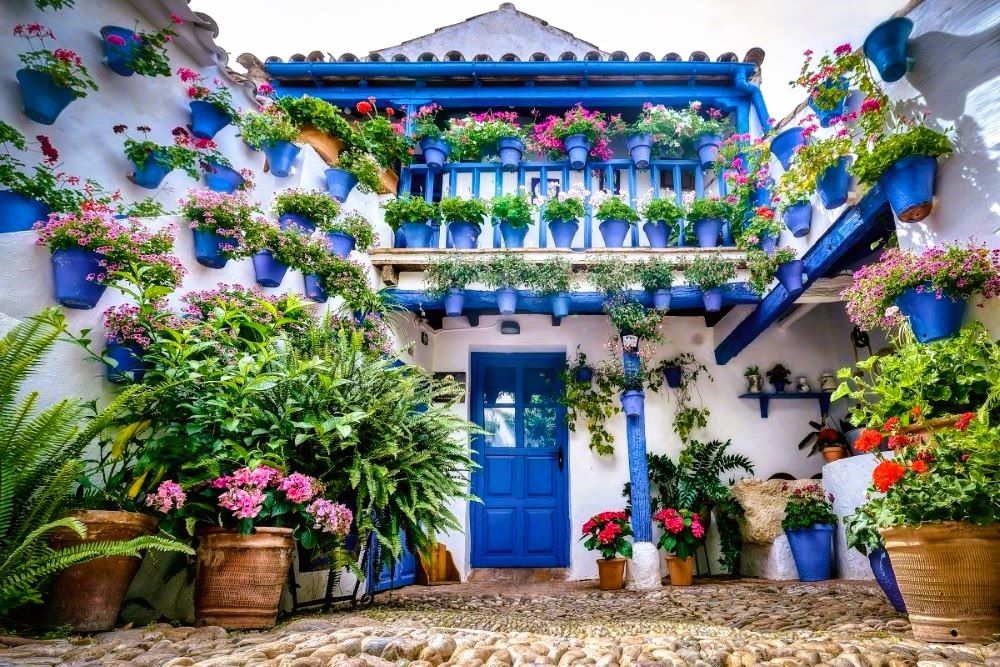
The best time to visit is during the Patio Festival in May. That’s when locals open up their private courtyards for everyone to see. People compete to have the most beautiful patio, and you can wander from house to house, smelling the flowers, hearing birds sing, and soaking in the peaceful vibe.
Even outside of the festival, you can visit some public courtyards, especially in the old town. The area around the Alcázar Viejo and San Basilio neighborhoods is full of lovely patios.
These courtyards show how Córdoba blends nature, history, and everyday life. They’re not just pretty—they’re part of the city’s heart and soul.
Each landmark in La Judería provides not just a snapshot of history but also bridges the connection between modern visitors and the Sephardic past that shaped Córdoba.
Cultural Highlights
Córdoba’s Jewish Quarter isn’t only about history preserved in buildings; it’s a living celebration of Sephardic culture, with events and initiatives that keep its spirit alive.
One notable project is Caminos de Sefarad, part of Spain’s Routes of Sepharad network. It actively promotes the shared Sephardic Jewish heritage across the country through cultural events, educational programs, and community projects. This initiative includes everything from guided walking tours in La Judería to thematic exhibitions that put ancient traditions into a modern context.
Moreover, Córdoba frequently hosts Sephardic music concerts, bringing hauntingly beautiful melodies to intimate courtyards and larger, historic venues. These events attract locals and travelers alike, turning the quarter into a hub of cultural exchange.
If you’re interested in exploring more about the Jewish heritage in Spain, the Judería de Córdoba page provides deeper insights into its historical significance.
Take your time exploring these offerings, and you’ll come away with not just photos, but a richer understanding of what made and makes this district so remarkable.
Where to Eat in and Around La Judería
La Judería, Córdoba’s picturesque Jewish Quarter, isn’t just about history—it’s a haven for food lovers too. While strolling the charming cobbled streets, you’ll stumble upon some of the most delightful eateries offering everything from traditional Andalusian tapas to authentic Sephardic-inspired dishes. Here’s a guide to some incredible places where flavor and history come together.
Tapas Bars Worth Visiting
Córdoba is renowned for its lively tapas scene, and La Judería doesn’t disappoint. From bustling local hangouts to cozy hidden spots, the Quarter offers a variety of tapas bars that seamlessly combine history, ambiance, and amazing flavors.
- Casa Pepe de la Judería
Located just steps from the Synagogue, this iconic restaurant offers a quintessential Andalusian experience. Known for its elegant rooftop views and authentic dishes, it’s perfect for unwinding after a day of sightseeing. Treat yourself to their flavorful salmorejo, a local chilled tomato soup, or their berenjenas fritas (crispy fried eggplant). More details are available about this popular spot on the Michelin Guide website. - Bodegas Mezquita
A lively and bustling venue that serves up local wines and a stellar array of tapas. Highlights include rabo de toro (oxtail stew) and flamenquín cordobés (a breaded roll of pork and ham). Pair any dish with a glass of Montilla-Moriles wine for the full Cordoban experience. - Taberna Casa Salinas
Tucked away within walking distance of La Judería, this family-run taberna delivers traditional flavors with a personal touch. Don’t miss their carrillada (braised pork cheeks) or the hearty garbanzos con espinacas (chickpeas with spinach).
Each of these spots balances flavorful plates with a welcoming and authentic Andalusian vibe.
Sephardic-Inspired Dining
For a culinary journey into Córdoba’s Jewish heritage, look no further than the selections of Sephardic-inspired restaurants around La Judería. These eateries honor the past by celebrating delicacies rooted in Jewish tradition.
- Casa Mazal
Translating to “House of Fortune,” Casa Mazal offers an intimate dining experience where the focus is on rich Sephardic flavors. Here, dishes such as albóndigas con canela (meatballs with cinnamon) and berenjenas con miel (eggplant with honey) reflect the deep culinary traditions of the community. - El Choto de San Hipólito
This atmospheric venue blends Sephardic inspiration with Andalusian flair. Standout menu items include dishes like stewed lamb-infused with herbs and spices reminiscent of medieval Jewish recipes. - Restaurant Arbequina
A short walk from the heart of the Jewish Quarter, Arbequina combines fresh Mediterranean ingredients with subtle Sephardic touches. Whether you’re drawn to the olive-rich stews or the aromatic slow-cooked lamb, it’s a memorable stop.
Enjoy these rich flavors while soaking up the ambiance that makes La Judería a food lover’s paradise.
Practical Tips for Visiting the Jewish Quarter
Visiting the Jewish Quarter in Córdoba, Spain, was one of the highlights for us.
Getting the Most Out of Your Visit
To truly make the most of your time here, a thoughtful approach can go a long way.
- Plan Your Path: The narrow, winding streets can feel like a labyrinth. It’s all part of the charm, but having a map—digital or paper—can prevent disorientation. Streets like Calleja de las Flores are unmissable but can get crowded in peak seasons. Early mornings or late afternoons are the best times to explore.
- Take Breaks: Feel free to pause at one of the cozy squares or patios. Plaza Tiberíades, home to Maimonides’ statue, is a beautiful spot to recharge your energy.
- Focus on Key Spots: Prioritize iconic landmarks like the Córdoba Synagogue and Casa de Sefarad. These sites give you a snapshot of the area’s cultural and historical essence. Want to dive deeper into what makes Córdoba extraordinary? Check out Is Córdoba Spain Worth Visiting?.
- Navigate With Care: Wear comfortable shoes, as the streets are often cobbled. They add character but are less forgiving on your feet!
For dining opportunities, look out for local cafes tucked into hidden corners—they often feature traditional Andalusian flavors blended with Sephardic culinary heritage.
Guided vs. Self-Guided Tours
When exploring La Judería, deciding between a guided or self-guided approach can significantly impact your experience. Both options come with unique benefits depending on what you’re after.
Guided Walking Tours
If you’re keen to uncover hidden stories and historical nuances, a guided tour is ideal. Experienced guides often share fascinating anecdotes that bring the Jewish Quarter to life. Many tours customize itineraries to include off-the-beaten-path gems. You can book reliable guided tours through platforms like TripAdvisor’s La Judería Reviews.
Pros:
- In-depth context about the Sephardic community and key sites.
- Direct access to local insights and lesser-known facts.
- Less concern about getting lost in the intricate streets.
Cons:
- Fixed schedules may limit flexibility.
- Groups can sometimes feel rushed or crowded.
Self-Guided Exploration
Prefer to set your pace? Self-guided tours let you linger longer at spots that resonate with you. Resources like GPS-enabled walking guides, such as Cordoba Jewish Quarter Walk by GPSMyCity, offer an excellent mix of freedom and structure.
Pros:
- Total flexibility with your timing and interests.
- Affordable options, using free maps and digital tools.
- Freedom to adapt the tour spontaneously.
Cons:
- May miss historical depth without an expert guide.
- Requires more effort in researching and navigating.
Whether you opt for an escorted journey or choose to wander solo, there’s no wrong way to soak in the atmosphere of Córdoba’s rich Jewish heritage. The key is tailoring your visit to your curiosity and comfort level.
Every visit to La Judería unravels new layers of history and beauty. By balancing cultural exploration with a bit of leisure, you’re bound to leave inspired by this splendid corner of Córdoba.
Conclusion
Córdoba’s Jewish Quarter is more than a historical site—it’s a vibrant connection to the city’s multicultural past. Wandering through its narrow streets, discovering its landmarks like the Synagogue and Casa de Sefarad, and learning about the legacy of Maimonides, you can’t help but feel its enduring significance.
This quarter offers a unique mix of preserved beauty and fascinating stories that make it a must-visit for anyone exploring Córdoba.
So, pack your curiosity and start exploring.
Related Posts:
Other Posts:
-
Lake Bled Day Trip: The Perfect First-Time Adventure from Ljubljana
Welcome! If you’re spending time in Ljubljana and want to experience Slovenia’s most magical landscapes, a Lake Bled day trip from Ljubljana is an easy choice. With its glacial blue water, Lake Bled Island at its center, and Bled Castle perched high on the cliffs, this spot looks straight out of a fairytale—no need for…
-
Best Things to Do in Ljubljana, Slovenia (First-Time Visitor’s Guide)
Welcome! Thank you for visiting my blog about the best things to do in Ljubljana! In this guide I’ll share my own favorite spots and handy tips, best places to eat and some local insights you might not find elsewhere. Ljubljana, the charming capital of Slovenia, is stunning! The architecture is breathtaking! I promise you,…
-
Best Tango Shows in Buenos Aires: My Guide for First-Time Visitors
Buenos Aires is the birthplace of tango – raw, passionate, and unforgettable! But if it’s your first time in the city, choosing the right tango show can feel overwhelming. Do you go for the glamorous, cabaret-style performance with a gourmet dinner? Or do you slip into a smaller, historic venue where tango feels more like…
-
Recoleta Cemetery in Buenos Aires: History, Highlights, and Visitor Tips for 2025
Welcome to Recoleta Cemetery! “If you’re visiting Buenos Aires, this is a place you should see at least once. You’ll leave with photos, stories, and a deeper understanding of Argentina’s history.” Related Posts: Introduction: Why Visit Recoleta Cemetery? Recoleta Cemetery in Buenos Aires is not your typical graveyard.It’s more like an open-air museum filled with…
-
Tokyo vs Osaka: Your Guide To Understanding The Difference Between The Two Most Popular Cities in Japan [2025]
So the question is, Tokyo or Osaka which is better? Do you want to pick between the two? It can feel like it’s hard to decide, especially if it’s your first trip to Japan. We’ve been to both. We loved them both. We spent more days in Osaka than we did in Tokyo, and did…
-
The Ultimate 5-Day Itinerary in Tokyo: A Fun and Easy Guide for First-Time Visitors
5 Day Itinerary in Tokyo – A City of Contrasts and Wonders I’ve created this 5 day itinerary in Tokyo to help you get the most out of your time here. It’s based on my own experience in this incredible city. Tokyo is one of the most exciting cities in the world. It’s a place…

